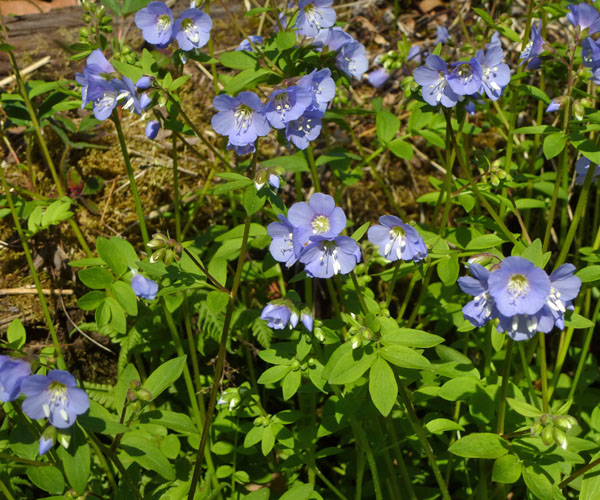Home Resources Gardener News reprints: Greek valerian/Jacob's ladder
This article by Hubert Ling (NPSNJ horticulture) was published in Gardener's News without the photos. He is a regular contributing writer to Gardener's News. Photos by H & M Ling.
Greek valerian/Jacob's ladder

May is the time when shady, moist areas of your garden should break out with the joyful blue of Greek valerian or as it is sometimes commonly called Jacob’s ladder. This plant is such a prolific bloomer that it may look like a piece of the sky has fallen down and landed right in the midst of your garden. The numerous blue flowers are bell-shaped and measure about 2/3 of an inch in diameter and have a light, sweet fragrance. There are 5 tooth-shaped sepals, 5 short stamens with white anthers, and 5 petals. There is a single pistil which when mature ends into 3 elongated spreading stigmas. The flowers are replaced by a 3 compartment ¼ inch capsule with just a few seeds.
The common name Jacob’s ladder refers to the 8 inch long delicate compound leaves whose 7-13 leaflets look like rungs on a ladder which lead up to the blue heavens just like in Jacob’s dream in the Bible. The plants tend to be a bit floppy and are only 12-18 inches high.
The scientific name for this plant is Polemonium reptans. Polemon is the Greek name of several famous kings and philosophers. Reptans refers to the fact that the plant spreads (slowly) by the use of underground creeping rhizomes. As a side note Polemon is also, unfortunately, the genus name used for several rare, poisonous snakes of central Africa.
Polemonium reptans is an uncommon but widespread perennial plant in Canada and almost all of Eastern US. It is more abundant west of the Appalachian Mountains. In NJ it is a rare plant found in only 8 counties along the banks and floodplains of the Delaware River. Even in these 8 counties the plants are very rare; I have never seen it in the wild in NJ.
Greek Valerian prefers light to almost full shade with a slightly acid to neutral rich soil. Although it prefers moist areas it also grows well under standard garden conditions and sandy soil, but it will go dormant under drought conditions.
Propagation is by separating the rhizome clumps or by seed. The plant self-sows if given the space but is not very aggressive. Sow the seeds as soon as they ripen for the best results. It is easy to maintain this gem in your garden but generally it just stays right where you put it unless you take the pains to divide it up for your friends. The plant doesn’t have any serious pests or diseases although 2 species of moth larvae mine the leaves and one type of aphid is occasionally found sucking the sap. Greek valerian is resistant to walnut trees and is moderately tolerant of deer and rabbit browsing. There is one common variegated cultivar: 'Stairway to Heaven'.
Another native plant, Polemonium van-bruntiae (also called Jacob’s ladder), is very similar to Greek valerian. However, P. van-bruntiae is a much larger plant which ranges from 1.5 to 3 feet tall. It is also more upright and tends to have longer leaves with up to 61 leaflets on each compound leaf. In addition P. van-bruntiae has long stamens which protrude 6 mm past the petals. Both plants are similar in habit and both are readily available commercially although I have found Greek valerian is much easier to grow.
Numerous flies, butterflies, moths, and skippers utilize the pollen and/or nectar of Greek Valerian. Andrenid bees, bumblebees, carpenter bees, cuckoo bees, halictid bees, honey bees, and mason bees visit the flowers. The bee species Andrena polemonii is a specialist on species of Polemonium. In the past native Americans occasionally used the rhizomes medicinally but the plant was soon replaced by safer and more efficient modern medications. As usual I strongly discourage experimentation using such a beautiful, and rare plant.
If you have a shady spot with dappled sunlight consider raising Greek valerian. You will be rewarded with soft patches of light blue every spring for generations to come. The bees, butterflies will also be blessed with this reliable low-maintenance natural gem. The plant grows well with Jack-in-the pulpit, Virginia bluebells, and cardinal flowers
For additional photos and information, click here